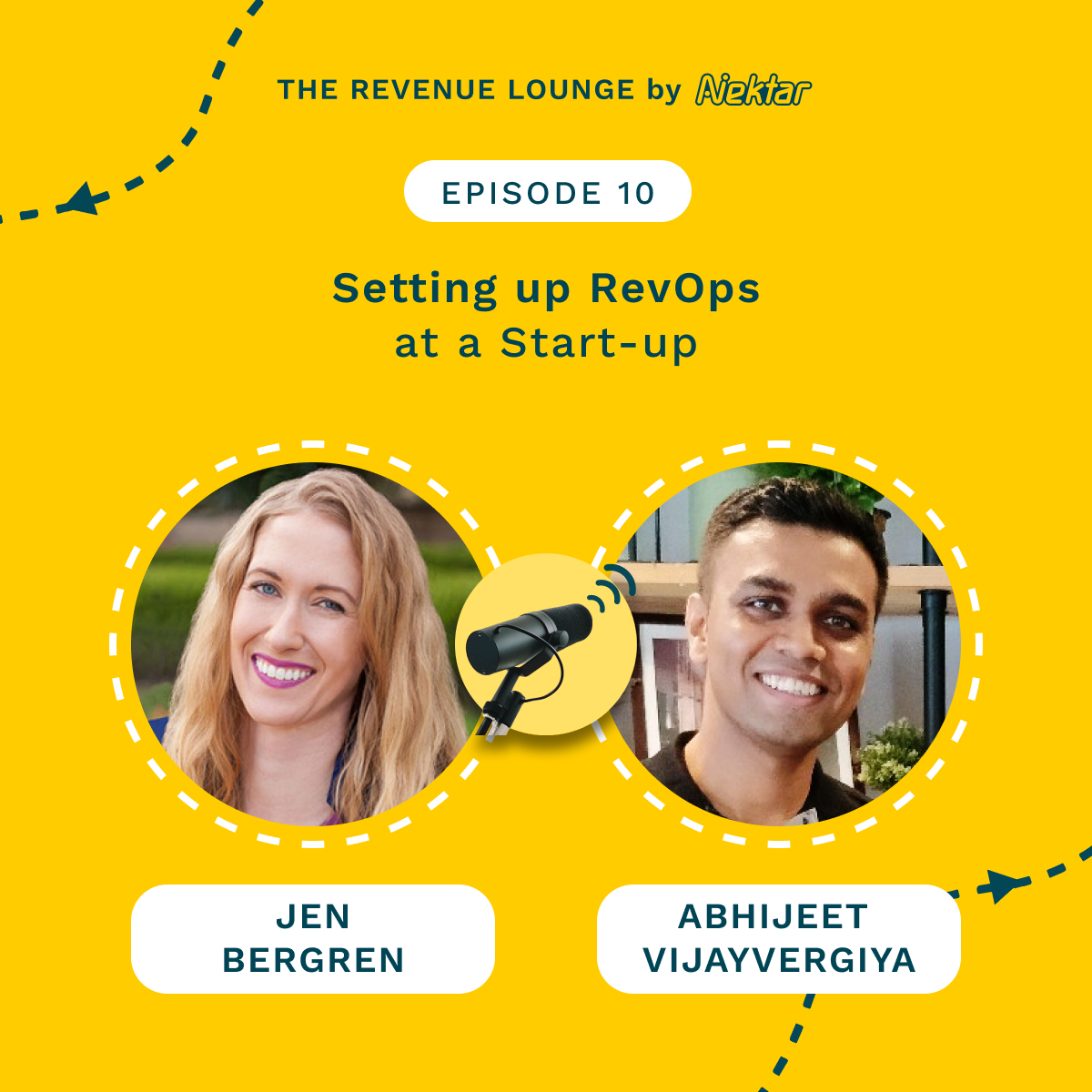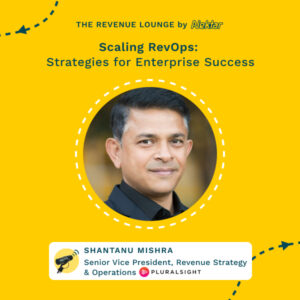Ep #11: Turning Data into Actionable Insights With RevOps ft. Vinny Poliseno
June 14, 2023
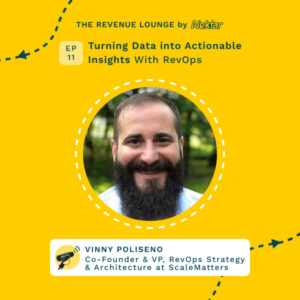
About
The Revenue Lounge
The podcast covers stories from leaders across RevOps, Sales, Customer Success, GTM, Data and Marketing about what drives these functions and what advice they would share with our listeners. With 3 seasons recorded, the podcast currently features 50+ enterprise leaders in the B2B SaaS domain. Tune in to hear from the best in the business
Welcome to Season 2 Episode 11 of The Revenue Lounge Podcast by Nektar.ai – A series of interviews with top Revenue Operations leaders on what drives the function and what keeps them going!
Episode Guest – Vinny Poliseno
https://www.linkedin.com/in/vinnypoliseno/
Episode Host – Bhaswati B
https://www.linkedin.com/in/bhaswati-bhattacharyya-9307768b/
Podcast Details:
Podcast page – https://nektar.ai/podcasts/
Spotify – https://open.spotify.com/show/3DUOqnTpPOJ2xbyl7HdgN3
Google Podcasts – https://podcasts.google.com/u/0/search/the%20revenue%20lounge
Apple Podcasts – https://podcasts.apple.com/in/podcast/the-revenue-lounge/id1645044872
Episode Details:

[00:00:00] Hello everyone. Welcome to the Revenue Lounge Podcast. My name is Bhaswati, and today we are going to talk about data, not just how to access the right kind of data, but to also drive actionable insights From it, to inform strategy and to educate us on this topic is our guest, Vinny Poliseno.
[00:00:19] Vinny is the co-founder and VP RevOps Strategy and Architecture at Scale Matters. He is a RevOps leader and a data expert who has helped companies accelerate their revenue growth by making data more actionable and accurate. Hi Vinny. Thank you so much for joining us today. I’m very excited to speak with you.
[00:00:39] Thank you for having me. I’m excited to be here as well. Yeah.
Awesome. You can start by telling us a little bit about your current role at Scale Matters. That would be great.
Certainly. So I basically founded Scale Matters with three other folks back in 2019. We went through a little bit of nights and weekends working on this sort of idea.
[00:00:57] In April of basically 2019, we all came over here full-time. We had essentially, Two of us had all worked together at a previous organization and we had come up with a process and a way to like tag our data to make it reportable from, you know, coming in as a recorder through the meeting component and opportunities created, done the deal.
[00:01:19] So look to sort of monetize that in a sense and help other organizations. So previously I was running all of our professional services. We did a lot of work where we were basically having folks migrate from one CRM to Salesforce. Along with just being their day-to-day tech ops team, right? We’re in sort of a world where it’s hard to get as an early stage organization, the investment to make into somebody that’d be part of your overall rev op.
[00:01:44] So we’re doing, you know, fractional team on that scenario. So we’re like their day-to-day running everything and anything you can think of. And part of it was also maintaining their data. So now you know, I’m focused more on our actual application and Salesforce integration. [00:02:00] Getting that a bit closer, making sure that there is a lot more configuration with the hopes by the end of the year to be at a sort of self-service model.
[00:02:08] Got it. So you said that you help people migrate their CRM. If you could tell me what are the kind of challenges that you face or companies face when it comes to migrating their CRM?
Yeah, 1000%. So one of the bigger challenges that I think a lot of organizations face when they go to do a CRM migration, Is they don’t actually think about a lot of this work to get there, especially when it comes to the data.
[00:02:33] So imagine if you’re going to move houses and you’ve been living in this house for 10 years, you’ve acquired a lot of things that now sort of live in a corner. They live in a box where ultimately it’s sort of trash and you don’t want to bring all that trash to you brand new house. You want us purge it.
[00:02:51] Where we’ve seen some areas happen is that, You know, you get to the point that we’re gonna do the migration. We’re at the point of saying, all right, what data is gonna come through? [00:03:00] And everybody just raises their hands and say, just grab everything. We’ll worry about it when it gets to Salesforce. And the worst part is now we just brought all this dirty stuff over into Salesforce.
[00:03:10] We’re almost repeating the pattern again. Um, you know, so the more that we’re able to sort of like educate our customers while we’re look at the data, try to enrich the data, have it make sense before it comes over. Is the ideal state. I mean, obviously it’s data, right? You can always go in and clean it or fix it or add it or enrich it.
[00:03:29] But if you can sort of avoid that, right? It’s, it’s possible. But you know, it’s a lot of work and a lot of the time people don’t realize that I’m gonna move from one serum to the other and it needs to be done in, you know, two weeks time. It’s just not really realistic. You need to understand what goes into it.
[00:03:48] What am I imagining is gonna look like on the end, at the end of it? And also pay attention throughout the entire process because you know, we’ll come through and we’ll demonstrate what we’re doing. What do these new processes look like? And everybody [00:04:00] just gives you, yeah, it looks good. It gets there until it’s go time and everybody’s like, wait, I don’t know this is gonna do that.
[00:04:06] Or, I didn’t realize that that automation’s gonna do this, so on and so forth. So yeah. Interesting. A little bit of a dejavu there as well. Because these are some of the challenges that we’ve also heard people go through when migrating. Thank you so much for sharing that. So moving on to the next question.
[00:04:22] Another fascinating thing about Rev ops leaders we speak to at Nectar is the journey that they undertook to get into this space. So would love to know your journey there too. I’m sure it’s a pretty special one. So how did you get into rev ops? What’s your story? I mean, it was completely pure accidental.
[00:04:39] I was previously running digital marketing, you know, website, social media, all that sort of stuff was starting to get pretty popular that Web 2.0 and the company I was working with at, you know, basically back in 2011, they had the day-to-day Salesforce admin just randomly up and quit and they had another backup plan.
[00:04:59] Uh, so I [00:05:00] mean, you know, they basically went out to the entire company and said, Who knows Salesforce or who wants to learn it. So I just kinda raised my hand and then, you know, here I am, 12 years later, still knee deep in Salesforce administration, those sort of roles and the operational side. Once I got my hands involved in it, it made a lot more sense cuz that’s the way that I think and process data is, you know, if then statements and that’s what a lot of Salesforce Kona is.
[00:05:25] If this happens, do that. Otherwise do this. Great. I love that. It’s interesting because a lot of people say this who have been in rev ops, that it has been something completely unplanned or it has fallen into their lap out of nowhere. And yours is also an interesting story in that category. So my next question is something we again, ask all our guests is how they look at revenue operations.
[00:05:48] So how would you define this particular function? Yeah, for sure. So, you know, revenue Operations is essentially a group of people who are focused on generating your leads. Creating your opportunities, [00:06:00] building your pipeline, your deals, and then maintaining those customers, right? So they’re all part of the revenue of that organization.
[00:06:07] And I feel like a lot of folks is now, previously somebody who was an ops roll is now just rev ops, where it’s a group of people, right? So it’s not just like the tools that are being used, it’s also the strategy, how it’s supposed to happen, how it’s supposed to be measured. Got it. Really agree with that.
[00:06:23] I think we can move on to the topic of discussion today. We all know the importance of actionable data and the value that it can drive for an organization. So can you share some examples of this value that can be unlocked through actionable insights from data for our listeners that you have seen in your experience?
[00:06:41] One 1000%. So if you’re able to get to a full funnel analytics, So if I’m able to see the entire journey of, uh, lifecycle of a prospect or customer or whatnot, right? I mean, you need to be able to measure both your leads and contacts basically the same. You know, if you are in the Salesforce world, [00:07:00] they are two totally different objects.
[00:07:02] They don’t make a very easy report to treat both of them the same. Where now you’re comparing two different reports exporting into an Excel file or exporting into a data lake or a BI tool to merge ’em all together. Now you want to try to figure out where do those records come from? So what sort of brought them into my system or what was the last action that we started to follow up on them with?
[00:07:24] And then starting to, again, isolate yourself down, you know, when did you sort of basically get a meeting on the books? When did those meetings actually get held? Right? Because you may have an overzealous SDR that sets a ton of meetings, but none of their prospects ever show up, right? So that’s not ideal.
[00:07:40] You want to basically have a, a good show rate as well, you know, at least try to aim for about 75%. And then out of those meetings that are held, how many of those are turning into opportunities out of those ops, how many of those are turning into deals? And then sort of being able to have like this rep to rep comparison, right?
[00:07:55] What is one rep that really excels where they get 90% of their, their ops [00:08:00] through a deal stage, whereas your other folks only get 12%, right? What is that one person doing really well? What can be recreated or what’s their secret sauce that’s making things happen? And then just understand your sourcing strategies, right?
[00:08:13] What do you, is that essentially spending in your marketing side, you may be generating a ton of Facebook leads, but maybe those leads coming in, the SDRs can’t convert into a meeting being set, or they do a better job of just straight cold calling, right? They have a better list to focus on. So you’re starting to kind of understand your CAC metrics a little bit more, right?
[00:08:33] You maybe generated a ton of stuff, which goes nowhere, you know, which is not ideal. It looks really great on the marketing side, like, hey, we’re doing awesome here. But on the sales side, there’s no follow through or output. And I mean, that’s sort of where this revenue operations comes into play because there’s no longer a Salesforce marketing.
[00:08:50] We’re both part of the same team. How do we get us through the process? Yeah. We are all part of the same team. That could be like our mantra going forward. True. [00:09:00] Yeah. So the data silos, like you were saying, different departments, having their own understanding of data, that’s a big challenge. So what are some of these challenges apart from silos that companies face today when it comes to generating actionable insights?
[00:09:13] Because companies more often than not, possess a lot of data, like large amounts of data, but. When it comes to actually knowing what data to focus on and what kind of insights to drive out of it is where the challenge lies. So what are the challenges according to you there? I mean, bad data hygiene is probably one of the worst ones that happen, you know, so what I was gonna saying earlier, like data migrations, taking bad data over and just literally reliving the same cycle of kind of spinning your wheels in the mud.
[00:09:43] So, you know, there should be a couple things in the sense of like keeping an eye on this. So, You do roll out a new process cuz I now wanna start to measure these new data points. Okay, great. I put that into place, but I mean, you need to also go in and almost check for the first couple months, if not quarter, if not forever.[00:10:00]
[00:10:00] Just make sure that process is being followed and is collecting properly. Because the worst thing you can do is turn in sort of like a process today. And it sets the date of all, you know, today’s date on every single record, right? So, you know, historically, how can I go back and enrich that with the appropriate date it should have been hit with?
[00:10:18] Now the other piece of it is like not knowing what metrics to measure. You gotta spend a decent amount of time throwing a lot of spaghetti on the wall. There’s gonna be metrics that are gonna be kind of driven down from like board meetings and or executive leadership or new processes that are gonna roll into play cuz it’s time to commission or whatever the case may be.
[00:10:38] And you may not have all those sort of metrics there today, which is not the end of the world, right? Because rum wasn’t built in the day. And I mean, you just need to reiterate off of what you built upon. But being able to go back and consistently tag in that new data sort of field and then have it make sense or like you’re looking at stuff where there’s my date sequencing at a line.
[00:10:58] I’m looking for these weird data [00:11:00] anomalies. Kind of having a hygiene check and then just making sure that you have just all the same data points to call yourself through the entire journey. You know, because it’s hard to compare data to data if one sample set does not contain the same amount of metrics, but kind of makes comparing when apple to an orange, sure, they’re both the fruit, but they’re completely different things.
[00:11:20] They’re not in the same wheelhouse. Obviously part of it too is, like I had said before, right? You continuously invest in something at the top of the funnel is doing really, really well, but just does not get itself all the way down or keeping a, a rep on way longer than they necessarily should be. You know, because not everybody’s meant to be in sales or a sales organization, you know?
[00:11:39] And part of that is training, right? I’m not saying viciously go out there. If somebody doesn’t hit their golds, get rid of ’em. So can you work with them and have them adapt otherwise? You can’t just keep somebody on forever just because unfortunately you’re a kind person. You want to see them do well, but if they just can’t get with the program or get to the end result, you gotta make a [00:12:00] business decision and let reps go.
[00:12:01] Yeah. Great insights there, Winnie. Thank you so much for sharing that. And that makes like a perfect segue to the next question. So on one hand, we have the challenge of converting our existing data into actionable insights that can drive value. But on the other hand, we have this problem of not having the right data in the first place.
[00:12:20] So for example, systems like the CRM are often invested with bad quality. You have duplicate data, you have incorrect data, you have incomplete information, you name it, right? So how can companies tackle issues such as bad data, quality and duplication in their systems, and how do you suggest that they can go about approaching this massive problem?
[00:12:43] Yes. You know anybody I know of that has Salesforce there, CRM, you know, it’s always this tongue in cheek, right? Salesforce is our CRM of record. If it’s not in Salesforce, didn’t happen. But they all know that their Salesforce data is terrible. Every executive will run their own [00:13:00] Excel file. So now your head of sales is managing pipeline from Excel versus the actual opportunities in the system.
[00:13:07] Your CFO may be running recurring revenue from an Excel file that doesn’t replicate exactly what is showing in the Salesforce environment for your actual customers. And your CEO has something completely different that they’re using to roll up to the board that maybe massages all their sort of stuff.
[00:13:23] So the first thing is getting everybody to make sure that they are making a concerted effort to sort of make the CRM. The record of truth, but I mean, look, bad data’s gonna happen, right? There’s no way if ands or butts around it. I mean, you can put in as many guidelines or guide rails as you actually try to want to put in, but you’re going to find them, right?
[00:13:42] Duplicates happen, right? People merge records. They change records. They edit records. When you start putting humans in there and start. Modifying what like a system may have. You gotta run into weird anomalies. Uh, what you gotta be able to do though, is be able to find those sort of things. So having a data hygiene check that you as a rev hops person, [00:14:00] checks daily, once a week, once a month, once a quarter.
[00:14:03] It doesn’t necessarily need to be the same exact things you’re checking on those cadences, but you should do sort of like a pulse or quality check, you know, for duplicates. There’s obviously Salesforce’s native duplicate rules you can buy tools you can buy. You know the biggest thing you usually probably find those for is list imports because somebody doesn’t want to expend for like a third party tool cuz it’s times are tough.
[00:14:26] They don’t have the luxury to spend 20 grand on just a tool to import, you know, but have a process to follow. Is that what you’re doing it consistently each time? You gotta get buy-in, right? You gotta get everybody on the same page to say that we are gonna make a conservative effort, that we are gonna be better at data.
[00:14:41] We are going to basically make our best case here and empower people, right? If the executive team wants something, it needs to kind of go down to each of the intermediate managers to help drive the day-to-day, because like CEO to SDR, right? They’re probably not talking as much as we would [00:15:00] hope that they are, but they may not get the full picture as to why this is important for them to like.
[00:15:05] Disposition a meeting, you know, come back and say, did this actually happen? And then obviously just kinda look for data that’s already there, right? What can you build upon? Because you look at like opportunity stuff. There’s just some native things in Salesforce that you can tack onto that Salesforce is naturally tracking for you turn on your field history, right?
[00:15:23] Start tracking history. Unfortunately, it’s just from that point forward, you know, you got 10, 10 years of data with all these sort of changes and you just turned it on today. It’s just gonna be from this point and then sort of have a process, right? If you are gonna roll out some new sort of process, how do I enrich all my historical data?
[00:15:37] So like I was kind of saying earlier, not everything shows up with today’s date in that date field, right? How can I look backward and try to find when it actually is gonna cross that line, or when should I tag that event of happening? Great points. You’ve given like a great theory of how. We can approach this bad data problem.
[00:15:55] I’d like to ask you how you do things at scale matters. Is there a checklist that [00:16:00] you have when it comes to stopping yourself from falling into the pit of mismanaged data or how? How does the data governance process looks like for you? Maybe if you can share some insight around that. Yeah, I can’t stress it enough.
[00:16:13] I certainly think that you should have a data hygiene check, right? Whether you are personally doing it or you have another team member doing it, but it should be looking for data rule breakers. Right. This cannot have happened or this needs to have happened a certain way. And then when you do find these anomalies or these rule breakers, do an investigation, and this could be a very great way to train up a junior member, right?
[00:16:38] Here’s actual data coming in. We are expecting this flow or apex trigger or class or whatever to fire a very particular way, but it’s not. Right. How do we find that out? Why did this happen? Was it an end user? Did something weird? Was it a new web form that got created that didn’t have hidden fields? Is it a process that just from an automation standpoint is not firing the way that we expected it [00:17:00] to?
[00:17:00] So going. Figure out what that potential root cause is. Fix that data, put a fix in place, but continuously monitor it. Right? You gotta keep kind of monitoring these things because you know, I would love to get to a point that sort of says like this process in is running and never, ever changes or does not need to be reviewed.
[00:17:18] But when you got so many different humans interacting with the records, you need to keep a pulse check on what’s going on. Yep. And who should own that hygiene check? Who should be accountable for it and who? Yeah. I mean, you know it, it should be a little bit part of that revenue operations group. In my mind, this is probably somebody who’s like an analyst is looking at that sort of stuff, so that way that person’s saying, the data that I’m trying to report off of is actually correct and accurate.
[00:17:42] Got it. Yeah. Going back to the point that you covered around data silos. So data is just, Trapped in multiple systems, right? And these systems often don’t talk to each other, giving different departments mixed views of what data means or what is the story it tells. So there’s just so much confusion because of [00:18:00] silo data.
[00:18:00] So from a rev ops perspective, what role can. Like Rev ops team play in breaking this kind of data silos and bring together the entire organization under a common understanding of data. Yeah. Awesome question. And a lot of the day to day, when people think Rev ops, they think it’s like one individual person, but in reality it should be like four different key contributors in this scenario, have your management person who’s like your strategic thinker.
[00:18:28] The person who’s corralling or kind of working with each of the division heads to get them what their business objectives are, what sort of data do they need, and what kind of frequency do they need to see that stuff? You know, folks that are dealing with your board, you have an enablement person where they’re essentially training your end user.
[00:18:46] They’re basically the super user of the system that you’ve built. When you put together a car, you’re expecting a car to drive 55 straight. But you have users that come in and they make a left hand turn at 80 miles an hour or a right hand turn. Or do a U-turn, [00:19:00] right? So sort of showing them the guide rails and also coming back with their feedback, right?
[00:19:04] So not only necessarily what did we build for you, but did I just make this harder? Did this previously used to take you five minutes? Now I’ve just added 10 more minutes cuz she gotta fill in five other validation rules has closed out a record. You know, then you have your insight folks, right? These are your analysts.
[00:19:19] These are the folks that are sort of looking at the data. They’re making sure that the data doesn’t have roll breakers. They’re there trying to make decisions on data. They’re there trying to make predictability or like data models, right? Sort of things that say if we hire more heads, Do we get to more opportunities if we invest in these ads?
[00:19:37] Do we get more opportunities or deals? And then you got your tool tech folks, right? So you need to have your day-to-day administrators that can tie all this data back and forth to one another. You get your marketing automation system, what key fields are coming back and forth? What’s driven from marketing automation versus CRM, your sales enrichment tool, right?
[00:19:56] How do I update? Things like if I’m a [00:20:00] sales rep, I just logged a call and said, the person told me to go screw myself and never call me again. I shouldn’t be able to make a disposition and kill that record so I don’t call them again in a week. Um, tying those things to together. So I do realize that realistically going out and having these four individual key contributors.
[00:20:18] Is not very likely or very high. So you may be looking at somebody who is wearing multiple hats, but they need to be able to specialize in these sort of different areas. To be able to put that hat on and say, okay, I’m gonna do training today, or I’m going to do data insights today. Because you know, the reality is, is I just feel like rev ops now is essentially what sales ops was.
[00:20:39] And everybody just kinda says they’re just gonna solve it, bring it over to rev ops. And that’s just not realistically fair and what a company should be doing. Great points there. And if we do talk about data, we have to talk about technology. You did touch upon it a little bit, but the tech stack and the processes that we set around it will play a huge role in making [00:21:00] data work better for companies.
[00:21:01] So what are the tech stack challenges today that prevent data from being actionable that you’ve seen or witnessed around you? Yeah, this is certainly one of these areas that you just never really connect the application properly. Uh, you don’t have your sync rules set up appropriately. One system’s controlling it where you expect the other one to bidirectional.
[00:21:22] You have like a nightly sync that runs from a whole another system that overrides stuff every single night. I’ve seen time and time again too, like you’ll buy a third party tool and they get you through the minimum viable connection. Right. Data is connected, it’s pushing back and forward. Cool or implementation done audios, but they don’t show you the other 85% of the things you can do with this sort of connection.
[00:21:45] And kind as a junior admin or a tech tool person, you may not know that, and that’s why you do want to have somebody with this insights or management sort of strategic thinking to understand. How else do I need to take these other third party things and show them in my serum, [00:22:00] or be able to show them from like a visual thing or report off of them or bring them into my data warehouse and be able to make actionable decisions off of them.
[00:22:06] Yeah, that makes sense. So in a market like now where there are budget cuts across the board and revenue leaders are being asked to drive efficiency, so technology will definitely be an ally in achieving this. Effective and efficient growth. Right. But it’s easier said than done. Choosing the right tools for the tech stack is often way more complicated, be it, you know, deriving ROI from it, driving adoption, or the tool actually adding value to revenue teams.
[00:22:35] Right. So for somebody who’s probably struggling with this right now and looking to procure some tools under a severely limited budget, what would be your advice? When it comes to selecting these tools for their tech stack and implementing them in a way that puts them at a step closer to generating better insights from the data that they have.
[00:22:58] Yeah, a lot of it is trying to [00:23:00] really understand what you have today, right? Because I’ve seen time and time again where folks will buy similar tools where they each have the niche thing that they solve, but one of ’em does both of ’em, which just doesn’t to the same extent, right? So try to get rid of.
[00:23:14] Duplicate tools that do sort of the same thing. Understand what data points you’re trying to really capture, right? Because there’s that build versus buy mentality, especially where we are now, right? What can I build internally is very unique to me versus what can I buy? Uh, you know, building is not always the best thing either because you may create it so unique that it’s so unique to your individual organization that if you make a process change or a business solution change.
[00:23:42] The entire thing that you just did may need to be recreated. Think about what you wanna sort of need today, tomorrow, one year from now, five years from now, because you’re not gonna get it right. I mean, you’re gonna buy technology today that’s gonna be acquired by somebody else, displays sunset [00:24:00] or something.
[00:24:00] Brand new is gonna come out in a year that’s gonna be even better and cheaper and faster. So what I would try to recommend is think about what is it I’m trying to solve? And then avoid trying to string too many tools together all at the same time. Because, you know, I’ve seen time and time again, I’m gonna do a CR migration plus a sales acceleration tool, plus a marketing automation system all in the same quarter.
[00:24:23] God bless you for making that attempt, but, um, you’re just setting yourself up for a disaster. Because ideally what you wanna do is stay highly like. Focused on the one tool that you are basically installing, and I’d say give yourself about a quarter worth of time to do this. You want to have about six weeks to do the implementation.
[00:24:42] Some of ’em, obviously this can be sped up, right? Depending on if it’s plug and play or whatever the case may be. But some of these orders, strategic tools may take a bit longer to kind of get going. You want to have about two weeks to train your users and then you have a month then to look for any sort of these data anomalies or tweaks that you want to continuously make now, over that quarter of a [00:25:00] period.
[00:25:00] So once you get yourself in a reliable, consistent data tagging standpoint, I think you’re then at the point to now we can look at the next tool and reiterate and rerun through that whole system again. Yeah. Thank you so much for sharing that. That brings us to the end of the first section of this podcast and we can move on to the next section, which is a hot favorite, the rapid fire section.
[00:25:22] So we ask these questions with an intent of getting to know you better. So let’s begin with that. Are you ready? Let’s rock and roll. So the first question is, what’s one book that you have loved in the recent past that you’d recommend? I’m not a huge book reader. I don’t have a great answer for this one, but what I would say is keep up on blogs that are out there, but my favorites that I have, automation Champion Salesforce, Ben, Salesforce flow some.
[00:25:48] Just to name a couple of them. Yeah, definitely. Those are our favorites as well. Thanks for those recommendations. We are also constantly on the lookout for grade blogs. Moving on to the next question, what’s your favorite part about [00:26:00] working in ops? Literally every day is going to be a new challenge. There is no day in my mind that’s ever replicable.
[00:26:07] There always are very different, and there’s a new. Need or urgency. Yeah. Great. So talking about good things, we also come to the controversial part of it. What’s your least favorite part about working in ops? It’s gonna be that same exact answer, right? It’s every day brings in a new challenge. You may have had out in your calendar, you’re gonna do a complete implementation of something today, but you just realize when your colleagues just disabled to flow, that’s no longer adding data.
[00:26:35] Or they just imported a list of 20,000 records that are all bad dates. So it’s. Kind of distractions. Reactive versus proactive. Fair enough. So who’s your one rev ops leader? Can be more than one about who you personally look up to and what, that’s a really tough question cuz there’s so many awesome people out in this community.
[00:26:56] Just to kind of rattle off a handful of ’em, I mean, you got Justin, Ben Fuller, Eric Lopez, sour Bush, Brad Smith, James MacArthur, Jackie Lee. Max Cohen, just to name a handful of folks that I’ll follow on LinkedIn or just in these sort of Slack communities that are out there. Yeah, we love them all and I know it’s a tough question to choose one.
[00:27:18] So moving on, this is something that I really love listening to because we get such amazing responses. Is there an advice that you received from someone that has stayed with you and you’d like to share with us today? Yeah. I always work out of a sandbox. Always do all your testing there. You can never really hurt anything that you can’t just retroactively roll back.
[00:27:38] And then if you are going to be working out of a sandbox and you wanna refresh it, just check with others before you do it. Cuz the worst thing you can do is click the refresh button. When somebody is knee deep into developing something new and they have not backed it up, you can ask for forgiveness to sort of do a rollback from Salesforce, but just.
[00:27:54] Always ask if you got a collective of people working in the same environment. Love that advice. Last one for [00:28:00] you. One piece of advice for people who’d like to have your job someday in Rev ops. Yeah. There’s a ton of valuable information that’s across the internet. A lot of my Salesforce stuff has been very self-taught from Trailhead, YouTube reading blogs, and you got this emergence of these Slack communities that there’s a ton of ’em out there.
[00:28:17] I mean, the one that I am probably closest to is. Wizards of ops, but with the overall, just the internet itself and being a lot of people that are jerks or trolls to one another, it just seems like in the revenue operations world, everybody is willing to bend over backwards to help you because we were all been in that sort of same shoes and you know, take advantage of that by all means.
[00:28:38] If I have the time and if somebody asks me to help them or understand something, I’m more than happy to always. Get on a call or schedule time or look at it via screen share, along with all those people I had mentioned earlier. All happy to help you troubleshoot how to get your best outcome. No, I totally second you on that.
[00:28:54] I’ve been in the communities and I think everybody would agree when I say that. If there’s something really special about this community, they’re [00:29:00] always looking out for one another and always helping each other out. So totally second you on that. Yeah. Thank you so much, Vinny. It was great chatting with you.
[00:29:08] Thank you for sharing everything so candidly, and I’m sure this will be very beneficial for our listeners. Data is something that there are so many questions around it and we are also trying to uncomplicate things around data and how rev ops can drive that. So thank you so much for giving us your time.
[00:29:24] You have a great day ahead of you.
Beautiful. Yeah, this is awesome. This has been a lot of fun. Thank you so much for having me. I had a great time chatting with you.

Ep #1: Navigating the Downturn with a Hyperfocus on Productivity
Listen Now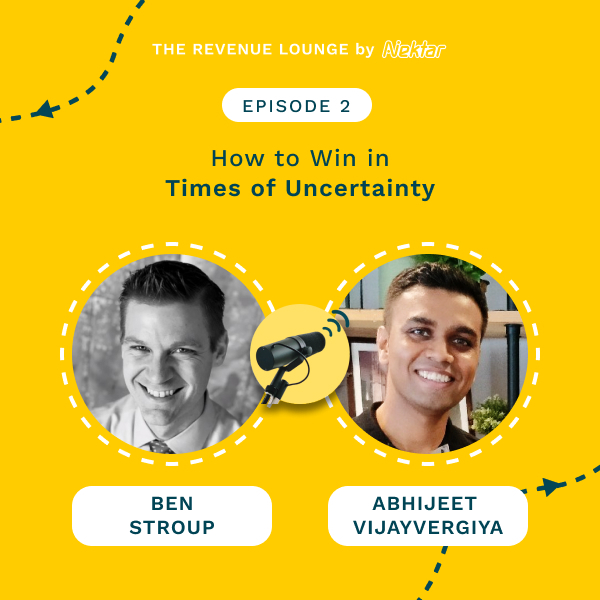
Ep #2: How to Win in Times of Uncertainty
Listen Now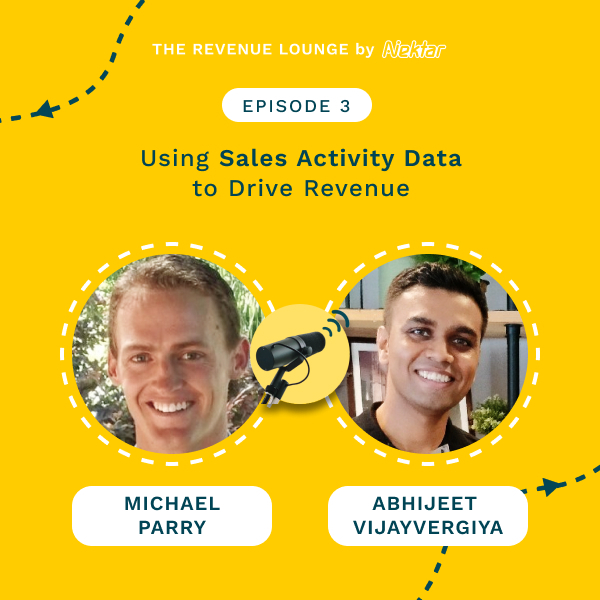
Ep #3: Using Activity Data to Drive Sales Productivity
Listen Now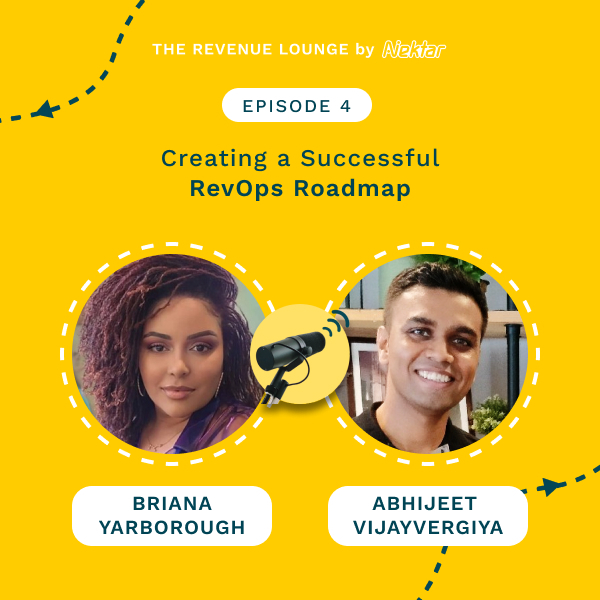
Ep #4: Creating a Successful RevOps Roadmap
Listen Now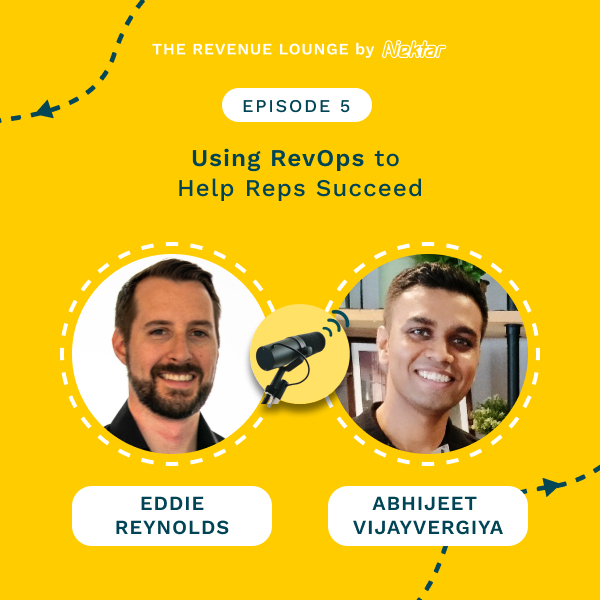
Ep #5: Using RevOps to Help Reps Succeed
Listen Now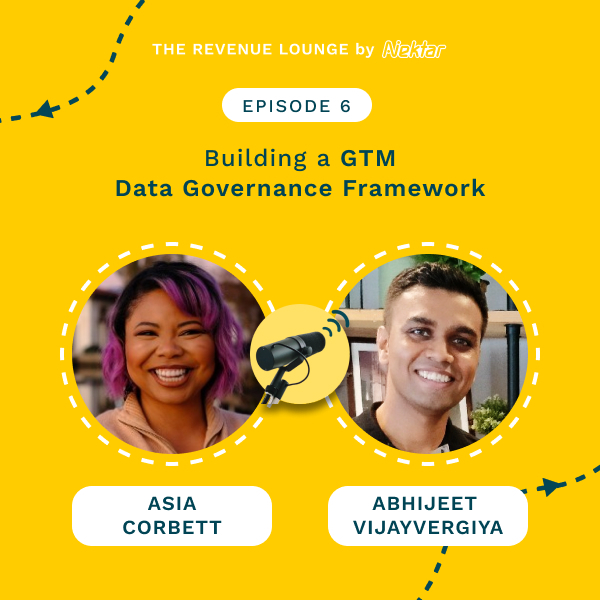
Ep #6: Building a GTM Data Governance Framework
Listen Now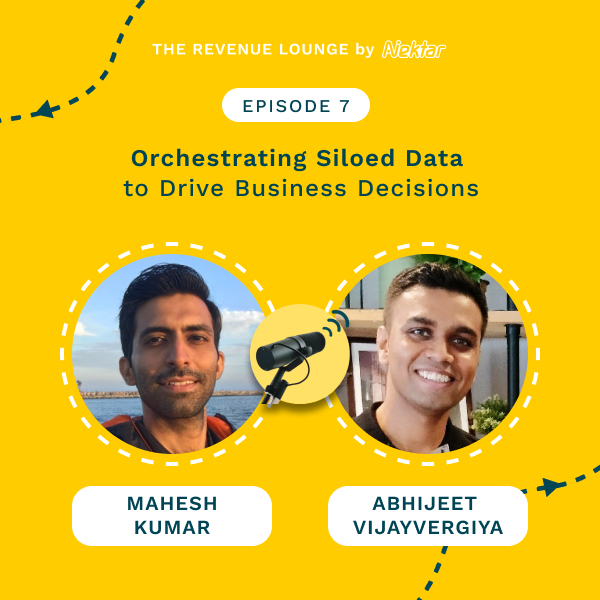
Ep #7: Orchestrating Siloed Data to Drive Business Decisions
Listen Now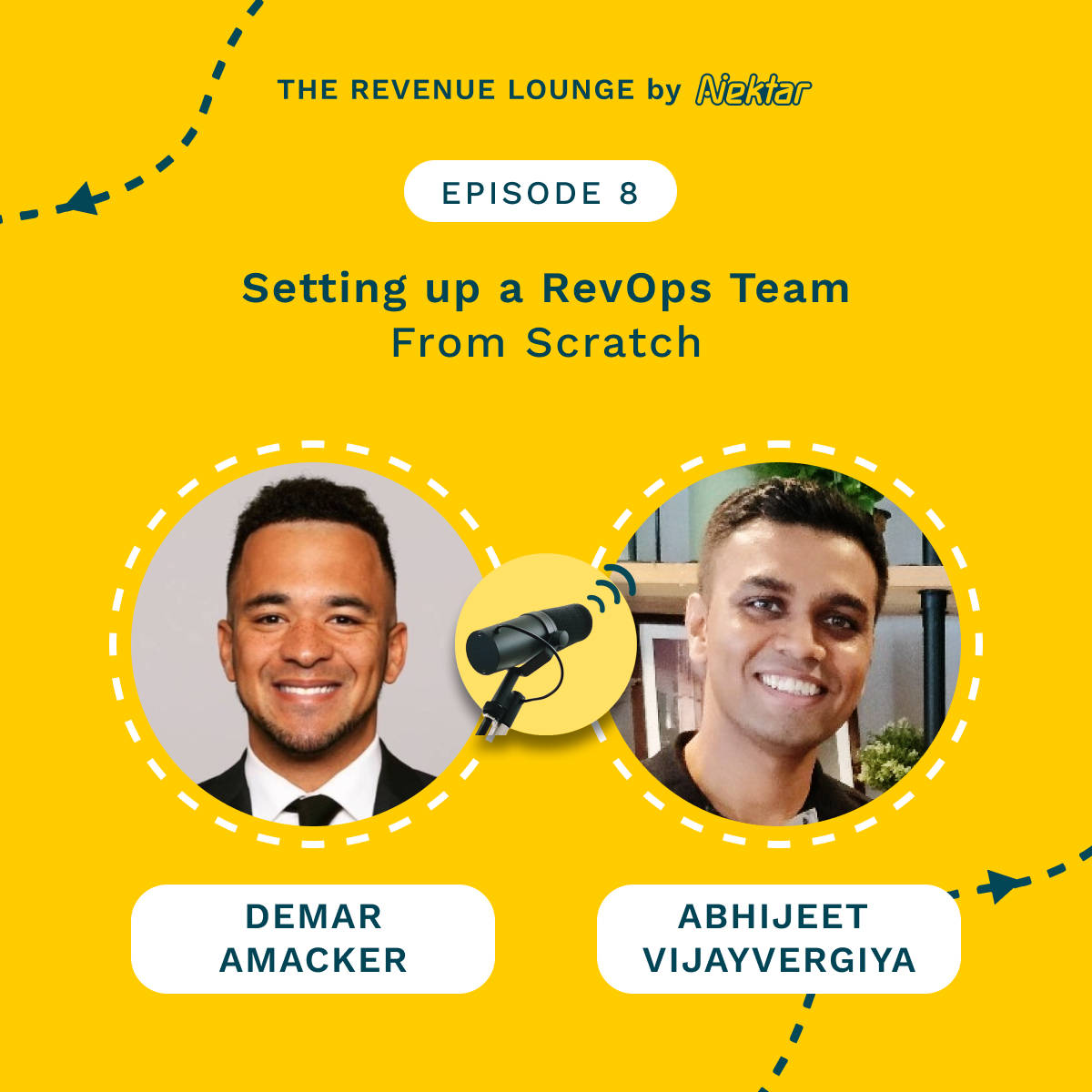
Ep #8: Setting Up a RevOps Team From Scratch
Listen Now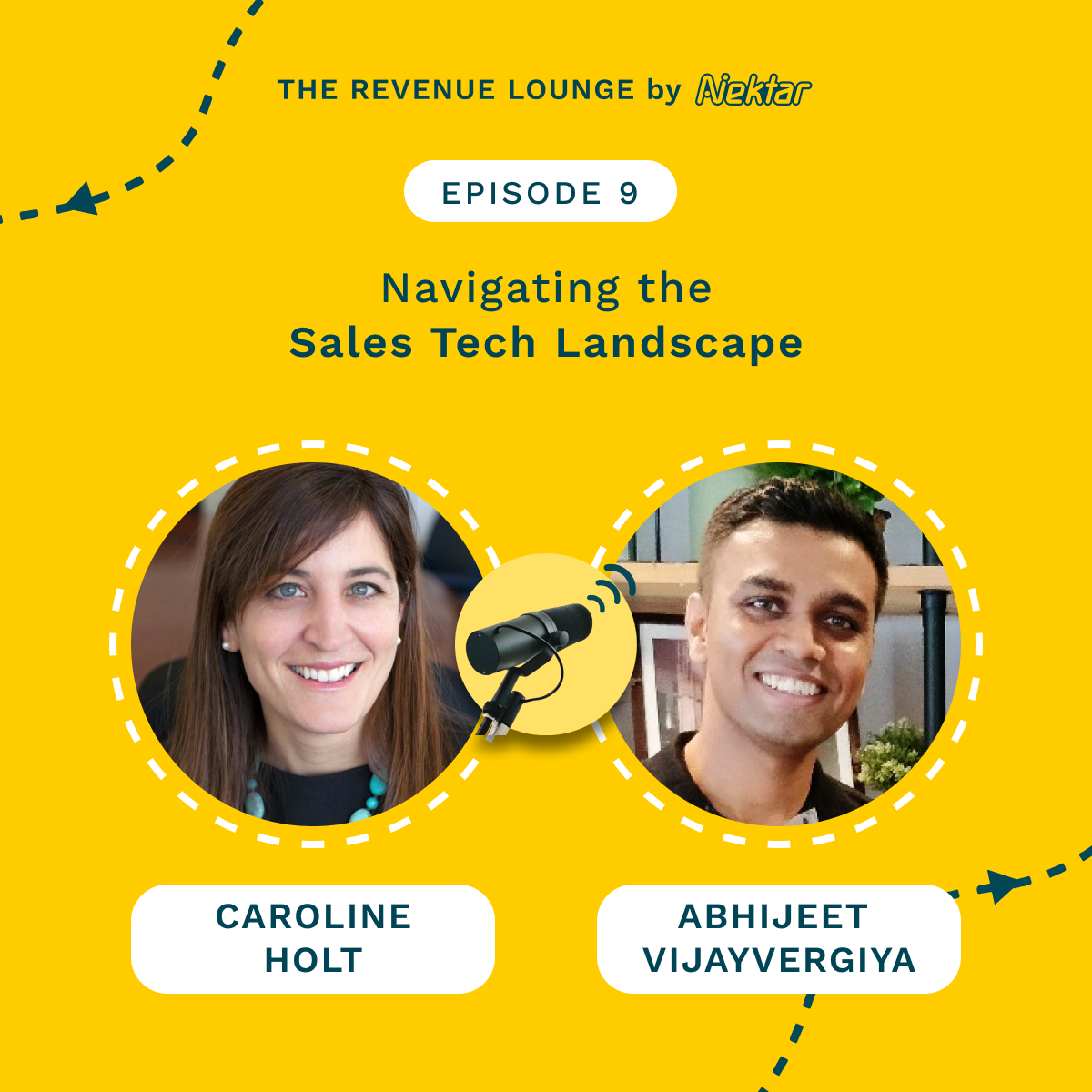
Ep #9: Navigating the Sales Tech Landscape
Listen Now